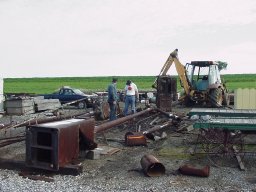 2000 7 8 7:47:48 AM Steve has been working since 7:00 AM to start dismantling
two of the remaining three units. We arrived about 1/2 hour later. One
scrapped base is back on its feet. Steve and Dick are looking at another
unit that the RR might still restore.
2000 7 8 7:47:48 AM Steve has been working since 7:00 AM to start dismantling
two of the remaining three units. We arrived about 1/2 hour later. One
scrapped base is back on its feet. Steve and Dick are looking at another
unit that the RR might still restore.
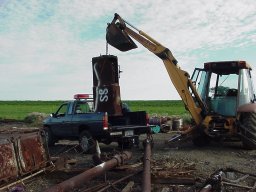 2000 7 8 7:53:40 AM A few minutes later the first scrapped base goes onto
our little pickup. (Man, were these things ever bigger than I remembered!)
2000 7 8 7:53:40 AM A few minutes later the first scrapped base goes onto
our little pickup. (Man, were these things ever bigger than I remembered!)
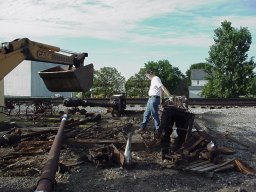 2000 7 8 7:59:28 AM Dick stands clear as Steve uses a back hoe to pull
the mast free from the second base.
2000 7 8 7:59:28 AM Dick stands clear as Steve uses a back hoe to pull
the mast free from the second base.
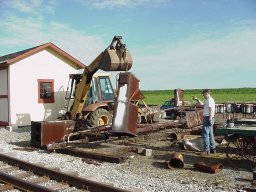 2000 7 8 8:04:52 AM Easy does it. You can see where the scrappers have
ripped away the sheet metal and already scavenged the actuator motors from
the mechanisms, presumably for their copper. :(
2000 7 8 8:04:52 AM Easy does it. You can see where the scrappers have
ripped away the sheet metal and already scavenged the actuator motors from
the mechanisms, presumably for their copper. :(
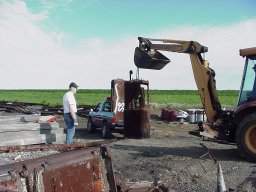 2000 7 8 8:09:12 AM This actuator does still have it's gears and gear cover
intact, as well as the contact bank. The base also has a few uncorroded
tie rods.
2000 7 8 8:09:12 AM This actuator does still have it's gears and gear cover
intact, as well as the contact bank. The base also has a few uncorroded
tie rods.
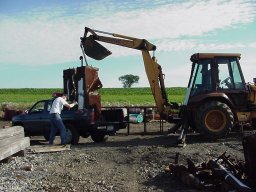 2000 7 8 8:11:16 AM Base #2 settles in next to the first one.
2000 7 8 8:11:16 AM Base #2 settles in next to the first one.
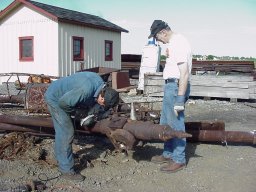 2000 7 8 8:23:16 AM This head is being salvaged as a spare unit for the
unit Steve hopes to restore for the RR.
2000 7 8 8:23:16 AM This head is being salvaged as a spare unit for the
unit Steve hopes to restore for the RR.
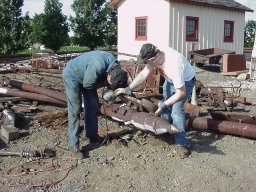 2000 7 8 8:25:56 AM This little portable band saw will not fit around the
mast, so the mast gets rotated as we cut. Hard toed boots are in order
for this sort of work.
2000 7 8 8:25:56 AM This little portable band saw will not fit around the
mast, so the mast gets rotated as we cut. Hard toed boots are in order
for this sort of work.
 2000 7 8 8:38:04 AM The photographer (my wife Karen) checks out some flowers
and bees as Steve and Dick continue the rescue task.
2000 7 8 8:38:04 AM The photographer (my wife Karen) checks out some flowers
and bees as Steve and Dick continue the rescue task.
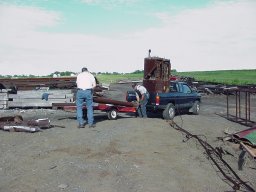 2000 7 8 8:42:32 AM Meantime, Steve and Dick load the lower half of a mast
onto the little trailer.
2000 7 8 8:42:32 AM Meantime, Steve and Dick load the lower half of a mast
onto the little trailer.
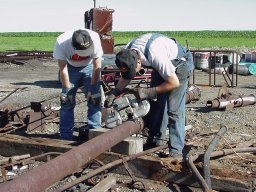 2000 7 8 8:50:14 AM They cut the mast and ladder into pieces for transport.
2000 7 8 8:50:14 AM They cut the mast and ladder into pieces for transport.
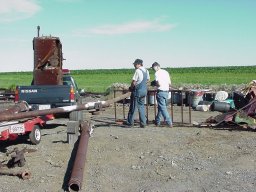 2000 7 8 9:05:58 AM The top half with it's head was too heavy to be lifted
in one piece by hand, so they swung it onto the trailer one end at a time.
(By now the back hoe was off digging or whatever back hoes normally do.)
2000 7 8 9:05:58 AM The top half with it's head was too heavy to be lifted
in one piece by hand, so they swung it onto the trailer one end at a time.
(By now the back hoe was off digging or whatever back hoes normally do.)
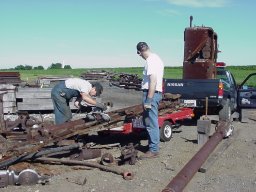 2000 7 8 9:16:04 AM Just one more cut and that ladder will fit OK.
2000 7 8 9:16:04 AM Just one more cut and that ladder will fit OK.
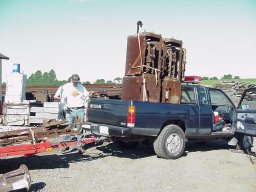 2000 7 8 9:26:40 AM Dick is eying the trailer a bit dubiously. I think
this load turned out to be heavier than we had planned for. In the background
you can see the base that Steve has been restoring.
2000 7 8 9:26:40 AM Dick is eying the trailer a bit dubiously. I think
this load turned out to be heavier than we had planned for. In the background
you can see the base that Steve has been restoring.
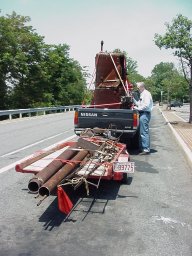 2000 7 9 2:02:08 PM Later, on the way home, Dick is checking the tie down
straps.
2000 7 9 2:02:08 PM Later, on the way home, Dick is checking the tie down
straps.
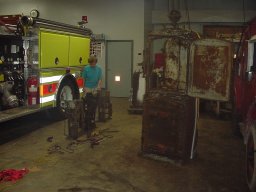 2000 7 10 9:03:24 PM A chain hoist in the fire station affords a way to
unload the bases. Karen is checking out the three partial mechanisms. Between
parts of the three there should be enough salvageable pieces for one completely
restored unit.
2000 7 10 9:03:24 PM A chain hoist in the fire station affords a way to
unload the bases. Karen is checking out the three partial mechanisms. Between
parts of the three there should be enough salvageable pieces for one completely
restored unit.
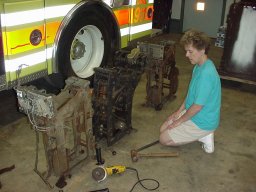 2000 7 10 9:04:24 PM The center unit had been removed from its base and
stored inside, so it is in better condition, but has been dropped. Fortunately
most of the broken pieces are still intact on the other units.
2000 7 10 9:04:24 PM The center unit had been removed from its base and
stored inside, so it is in better condition, but has been dropped. Fortunately
most of the broken pieces are still intact on the other units.
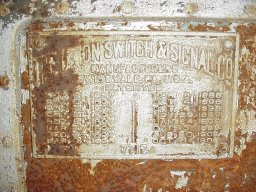 2000 7 10 9:36:48 PM The original nameplate.
2000 7 10 9:36:48 PM The original nameplate.
(c) Dick Bronson July 2000